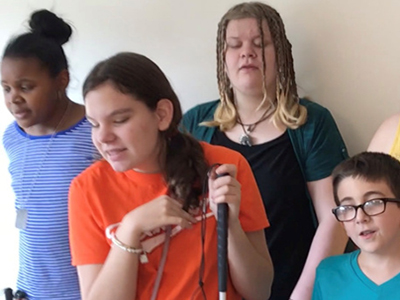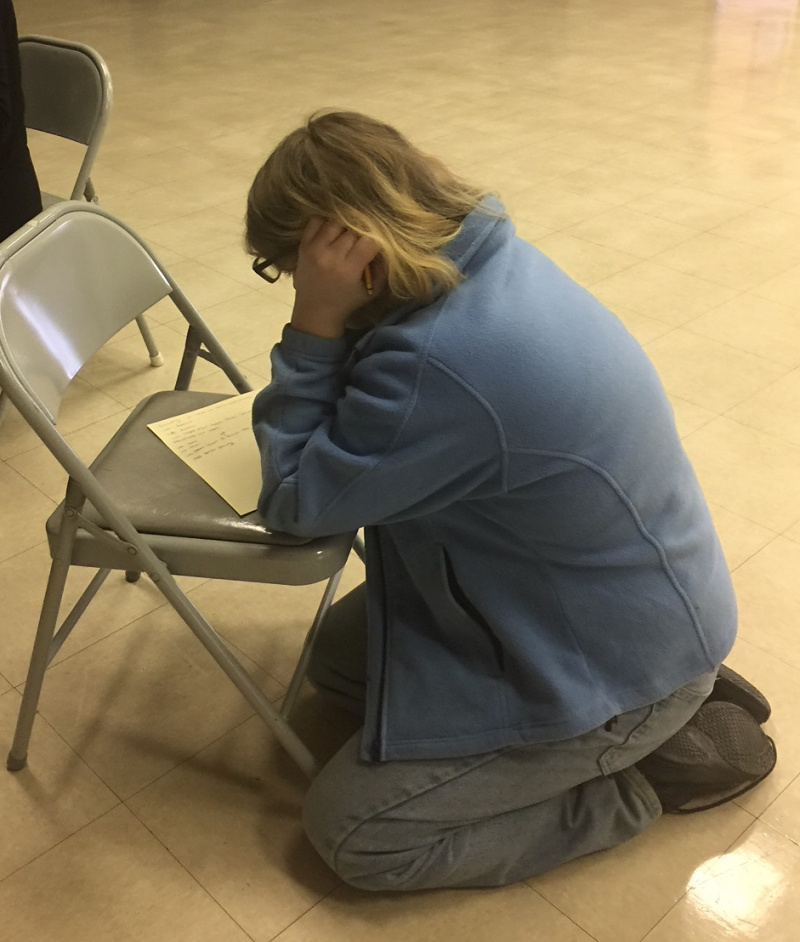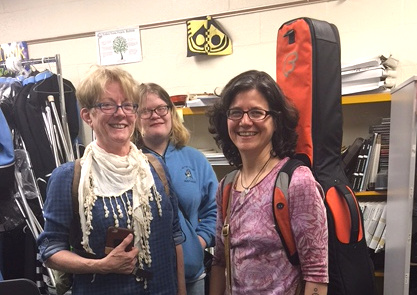
Seeing Through Music,
Part II
by Valerie Leonhart Smalkin
Recap
This article is about six teens with blindness who bravely revealed their hearts in song. CMN member Irene Light, Director of East Coast Productions for Theatre Arts Festival for Youth (TAFFY, a 501(c)(3) charity), created a songwriting program for the Maryland School for the Blind (MSB) Statewide Outreach program. That one songwriting session blossomed into a multiyear songwriting and recording project that still is not complete!
Part II
MSB Outreach Recording Day
When I left you last, I was riding high after Dave Kinnoin, Oliver Kinnoin, Mary Kincaid, Randy Sharp, and Jimmy Hammer opened their homes and hearts to Barbara Silberg’s amazing West Los Angeles Children’s Choir to record our teens’ second song, “The Dance of Freedom.” Since then, Mark Stocker graciously opened his recording studio to our MSB students. Our recording session was a great learning opportunity for all of us, especially me. To the merriment of my students who have blindness, I found myself giving visual cues. See my conducting errors in the studio in the accompanying video. You will note that by the end, I learned to tap the tempo on my students’ backs and softly run my hand across their shoulders to indicate how long a note should be held. I was not concerned with dynamics at that session, but I suppose pressure could be used to indicate volume. All of this this worked well except for one very ticklish student. Remember, of course, that one needs to ask permission before conducting by touch.
Mark mixed the teens’ vocals with Barbara’s choir. The final version of “The Dance of Freedom” will be released most likely in the fall of 2018.
Alex Plays Bach
While at Mark’s studio, Alex, a seventeen-year-old young man with autism, blindness since birth, and perfect pitch, had the opportunity to record a Bach Invention. Alex does not read Braille music notation and thus learned entirely by ear. Watch the video, and please notice the flourishes he includes. Such a talented young man.
Meanwhile, students changed the title of “Not With My Eyes” to “Life Beyond Sight” because, they argued, “not with my eyes” is negative and people might not be attracted to that title. Also, every time inveterate punster Irene Light heard the phrase “not with my eyes” she would respond, “Then with what?” That convinced me to go with the new title.
 Raiven writing
Raiven writing
The third song written in this program, “Lifeboat to Sanity” had its genesis at the fourth songwriting session when I asked the teens what music means to them. Raiven, who does not like to talk or be touched, mumbled, “a lifeboat to sanity.” I didn’t hear her at first, but when she repeated it, I was floored. I asked Raiven to expand upon her thought and she said that “music escapes the world of insanity...music involves relieving the stress through patterns...everything fits in one place—you know where it fits and you don’t expect the worst to happen.” She also shared that she is happiest when singing or playing an instrument, which was marvelous to hear because Raiven often appeared sullen. Over time I learned that the sullen exterior concealed a wealth of creative joy, though Raiven herself would deny this.
With funds from TAFFY Presents, we were able to engage local musician and songwriter Sahffi Lynne to meet with Raiven for several one-on-one songwriting sessions. At the first of those meetings, Raiven’s free-flowing, furiously scribbled, verbal dance produced the following:
My ancestors cried, struggled, and tried.
Not knowing when their hardship would end.
But the words of their song reach from them and to me
Music serves generations of sanity.
That horrifying version of reality consoles
Music my scribe which saved me from fear
From the dread others endured as they spread the word
Of hate, and it occurred
As the words of my song calmed those waves which hurt
As they save you from that long stood upon shore.
From being stranded on the shore.
The act of writing music is comforting
Enclose the flames of fury
Enclose the flames of unreal reality.
At the second meeting, Sahffi and I helped Raiven decide which lines to use from the many she wrote. Sadly, I do not have all of Raiven’s original notes; however, you will see how the thoughts from her writing above were crafted into the following song. The water theme remained strong.
Lifeboat to Sanity
Words and music by Raiven Everett, Sahffi Lynne, and Val Smalkin
© 2018 Small Kin Music
Chorus:
Music is a lifeboat to the world of sanity.
Away from the tragic realm of reality.
Where ev’ry thing fits, and fearsome thoughts submit
To the universal patterns of harmony.
Verse:
I feel your stare as you stand on the shore.
Darkness takes over, I feel so insecure.
The walls close in, the shadows grow long.
But, I save myself with the words of my song.
Chorus
Sometimes alone, alone and scared
An island of fear, yes, I feel stranded there.
But the songs of the world float over me
Calming the waves of insecurity.
Chorus
The Making of Lifeboat to Sanity
The melody was created by Raiven and Sahffi in this manner: Sahffi would ask Raiven to sing out one of the lines without thinking too very hard. Raiven was brave and would sing out clearly, then I notated her melody lines. Sahffi added the underlying guitar accompaniment and recorded a rough version of “Lifeboat to Sanity” for Raiven to listen to in preparation for her own recording session. Child’s Play Charity kindly provided MP3 players with tactile controls for all of our students to use. Watch the sweet little video of Sahffi’s recording session with Mark Stocker (right), and hear the entire song. The resulting melody, I think you will agree, is haunting.
Lifeboat to Sanity
Raiven recorded vocals at my own studio in May 2018, and her vocals will be mixed with Sahffi’s on the final recording. The students decided that “Lifeboat to Sanity” was better as a solo song, especially because not all of the teens agreed with the mood of Raiven’s song. Just as Raiven found “Dance of Freedom” too merry, the other teens thought “Lifeboat to Sanity” was too dark. This became perhaps one of the greatest learning opportunities of the entire program for Alex, whose autism takes the form of rather rigid thinking.
 Val with Sahffi Lynne, ready to play
Val with Sahffi Lynne, ready to play
At the beginning of the program, in December 2016, Raiven was describing how green looks black to her and yellow looks grey. Alex, who has never seen any colors, objected strongly, almost shouting, “No! Green is green and yellow is yellow! Green can’t be black!” In fact, this concept upset him so much that his social worker took him away from the group to work out the idea of colorblindness, and that what one person sees is not necessarily what the next person sees.
The following week, we were discussing beauty, and Grace Zuzarte, a lovely eighteen-year-old adopted from Pakistan, was saying that vanity is strange when you can’t see yourself, but beauty is the voice of love and the true you. The third week, Alex brought in the following verse on beauty:
Beauty isn’t just the looks when you can’t see a thing
It’s the voice of love striking you when you talk or sing.
It can be in one’s name, one’s personality,
The way you speak, the way you act, your energy.
Although I cannot remember the entire beauty conversation, I do remember Alex’s light bulb moment when his face lit up and he exclaimed excitedly, “Oooooh! I get it! Beauty is not the same to every person. People see it differently!” It was a great victory.
Returning to “Lifeboat to Sanity,” in Alex’s mind, if HE thought the song was too sad, well, then it was and shouldn’t be done. We did convince him that Raiven could go ahead and work on that song, and he did not have to take part.
This brings you up to date with our project. Raiven’s vocals are in the hands of Mark Stocker, waiting to be mixed. I am working on adding music and sounds to Raiven’s spoken word pieces, and I am toying with the idea of having each student read his or her original draft as a spoken word piece prior to the track with the finished song. And all of that will be mastered into a CD, Life Beyond Sight, that we hope schools for the blind can use as fundraisers. But the true value of the CD is that it shares the insights of these sightless and sight-impaired teens with the sighted. (Oh, how they would love that last sentence with all the uses of the word “sight.”) We will submit the songs to songwriting contests, and maybe one or two for Grammy nominations. Our goal is to finish the recording process in fall 2018.
This spring, The Baltimore Sun did a Sunday feature arts article about the students in our project with some wonderful videos. It delighted the children to be the center of attention for their work, but for me, the highlight of that article was this quote from Alex:
I liked that I got to write the lyrics to songs and actually record them for the first time in my life. I love all the changes we got to go through. [emphasis added]
Remember, this is Alex, the child who hates change. Can anyone doubt the positive power of music in children’s lives? I’m celebrating, for sure.